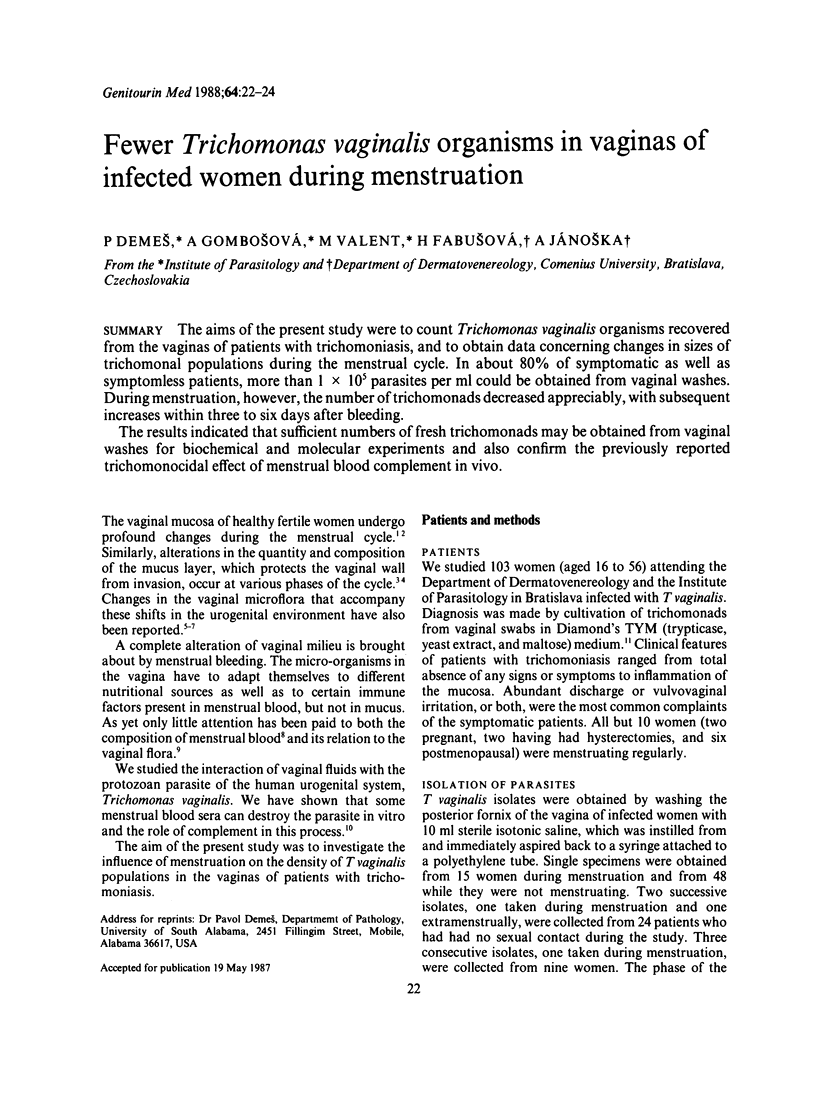Abstract
The aims of the present study were to count Trichomonas vaginalis organisms recovered from the vaginas of patients with trichomoniasis, and to obtain data concerning changes in sizes of trichomonal populations during the menstrual cycle. In about 80% of symptomatic as well as symptomless patients, more than 1 x 10(5) parasites per ml could be obtained from vaginal washes. During menstruation, however, the number of trichomonads decreased appreciably, with subsequent increases within three to six days after bleeding. The results indicated that sufficient numbers of fresh trichomonads may be obtained from vaginal washes for biochemical and molecular experiments and also confirm the previously reported trichomonocidal effect of menstrual blood complement in vivo.
Full text
PDF


Selected References
These references are in PubMed. This may not be the complete list of references from this article.
- Allardyce R. A., Bienenstock J. The mucosal immune system in health and disease, with an emphasis on parasitic infection. Bull World Health Organ. 1984;62(1):7–25. [PMC free article] [PubMed] [Google Scholar]
- Bartlett J. G., Onderdonk A. B., Drude E., Goldstein C., Anderka M., Alpert S., McCormack W. M. Quantitative bacteriology of the vaginal flora. J Infect Dis. 1977 Aug;136(2):271–277. doi: 10.1093/infdis/136.2.271. [DOI] [PubMed] [Google Scholar]
- Fleetwood L., Landgren B. M., Eneroth P. Changes in soluble proteins in cervical mucus during midcycle in normally menstruating women. Gynecol Obstet Invest. 1984;18(1):27–33. doi: 10.1159/000299044. [DOI] [PubMed] [Google Scholar]
- Gombosová A., Demes P., Valent M. Immunotherapeutic effect of the lactobacillus vaccine, Solco Trichovac, in trichomoniasis is not mediated by antibodies cross reacting with Trichomonas vaginalis. Genitourin Med. 1986 Apr;62(2):107–110. doi: 10.1136/sti.62.2.107. [DOI] [PMC free article] [PubMed] [Google Scholar]
- JOHNSON G., KUPFERBERG A. B., HARTMAN C. G. Cyclic changes in vaginal populations of experimentally induced Trichomonas vaginalis infections in rhesus monkeys. Am J Obstet Gynecol. 1950 Mar;59(3):689–692. doi: 10.1016/0002-9378(50)90256-0. [DOI] [PubMed] [Google Scholar]
- Johnson S. R., Petzold C. R., Galask R. P. Qualitative and quantitative changes of the vaginal microbial flora during the menstrual cycle. Am J Reprod Immunol Microbiol. 1985 Sep;9(1):1–5. doi: 10.1111/j.1600-0897.1985.tb00331.x. [DOI] [PubMed] [Google Scholar]
- KURNATOWSKA A. O ilościowych zmianach rzesistka pochwowego Trichomonas vaginalis Donné podczas cyklu miesiecznego. Wiad Parazytol. 1958;4(5-6):549–551. [PubMed] [Google Scholar]
- Landgren B. M., Ljung-Wadström A., Wikborn C., Eneroth P., Nord C. E. Microbial findings in genital secretions from seven healthy fertile couples. Med Microbiol Immunol. 1984;173(4):179–185. doi: 10.1007/BF02122109. [DOI] [PubMed] [Google Scholar]
- Rein M. F., Sullivan J. A., Mandell G. L. Trichomonacidal activity of human polymorphonuclear neutrophils: killing by disruption and fragmentation. J Infect Dis. 1980 Oct;142(4):575–585. doi: 10.1093/infdis/142.4.575. [DOI] [PubMed] [Google Scholar]


